Cornwall Electric
Cornwall Electric is an electricity transmission and distribution utility, licensed by the Ontario Energy Board (OEB), to operate in Cornwall, Ontario, Canada. Originally established in 1887 as Stormont Electric Light and Power Company, and merged with a railway company to become the Cornwall Street Railway Light and Power Company, it is one of the oldest utilities in Canada.
 | |
| Cornwall Electric | |
| Subsidiary | |
| Industry | Electricity distribution |
| Predecessors | Stormont Electric Light and Power Company (1887 - 1905) Cornwall Electric Street Railway Company (1896 - 1905) |
| Founded | 1887 in Cornwall, Ontario |
| Founder | Wilbur Reuben Hitchcock |
| Headquarters | |
Areas served | Cornwall, South Glengarry, South Stormont, Akwesasne |
Key people | Jacqueline Baird (Regional, Manager) |
| Owner | Fortis Ontario Inc. |
Number of employees | 211 (Fortis Ontario) (2020) |
| Website | cornwallelectric |
The company supplies electricity to approximately 24,800 customers in the city of Cornwall, the townships of South Glengarry and South Stormont, and on a portion of the Mohawk people's territory of Akwesasne, all located in Eastern Ontario. It crosses provincial boundaries to obtain the bulk of the power it requires directly from Hydro-Québec, while generating a small amount of its own, using a cogeneration system, a first such use in Canada.
Cornwall Electric has played an active role in the development of Cornwall, where Thomas Edison would demonstrate his invention of electric incandescent lights, achieving an important milestone in the development of the electrical industry in Canada. Cornwall Electric has undergone several ownership changes, and has transitioned from being a private company, to a municipally-owned utility, to one that is now owned and operated by a multinational publicly traded company. Having ownership of Cornwall Electric has allowed the city of Cornwall to be debt-free, and to establish a Progress Fund that would finance various community projects and initiatives.
The company has also been granted legislative exemptions by the provincial regulator, while it holds long-term Franchise agreements with the municipalities and townships it serves, enabling it to provide electricity consumers with some of the lowest rates in Ontario.[lower-alpha 1][1][2]
Name
Cornwall Electric is the amalgamation of two companies that were first established in the late 19th century in Cornwall, Ontario, Canada. Stormont Electric Light & Power Company, which was formed in 1887 to supply Cornwall with electric light,[3]:V and the Cornwall Electric Street Railway Company, which incorporated in 1896 after receiving a franchise to operate a street car service in Cornwall.[4]
The two companies would amalgamate in 1905 and would derive a new name from the two original company names, to become Cornwall Street Railway Light and Power Company Limited. It would over time, divest itself of all its railway operations, but would retain its full corporate name.[3]:V
In 1972, the company branded itself with the orange "CE" logo, and continued doing business as Cornwall Electric. While the company was attempting to incorporate provincially using the name Cornwall Electric, a new company which manufactured small electric appliances, was incorporating federally with the same name. Executives from both companies held meetings and made arrangements that would allow the utility, which had proceeded further in obtaining the name, to continue operating as Cornwall Electric. It would provide the other firm compensation for any problems that would arise, after it decided to forgo the use of the name Cornwall Electric in lieu of another. [3]:89-90,254
History
Early years
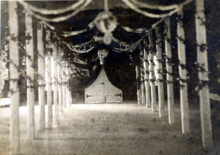
In 1883, the owners of the Canada Cotton Manufacturing Company invited employees of Thomas Edison to Cornwall, to install the inventor's direct current (DC) system of incandescent lights, to illuminate their new weave shed. H.M. Billsby, director of the project, hired local Cornwall workers, including John MacMillan and Wilbur Reuben (W.R.) Hitchcock, who would install six boilers, six generators, and one hundred carbon filament bulbs connected in series and suspended from the shed's ceiling. Edison himself went to Cornwall a year later for the weave shed's opening, as did politicians, scientists, industrial leaders, and dignitaries. He activated the system and saw for the first time in Canada,[5] factory illumination using his patented invention of electric incandescent lights.[6] This would be an important first step in the development of Canada's electrical industry.[3]:9
John MacMillan was placed in charge of the generators at the textile mill by H.M. Billsby, and after two years there, would go on to install generators at various locations for the Edison Company, which would become part of the General Electric Company. He would return to Cornwall to work for Stormont Electric before purchasing his own electric shop.[3]:9
W.R. Hitchcock, who in 1883 at the age of twenty-one, moved to Cornwall from Massena, New York, worked as an electrician for the Edison Company for a few years, and would later join Billsby who had become the first manager of the Westinghouse Electric Company. He would become a partner of the construction firm Glover, Davis and Hitchcock of New York, installing plants for Westinghouse that produced electricity using an alternating current (AC), which allowed it to travel longer distances, compared to Edison's DC system.[3]:10
During a visit to his Cornwall home, Hitchcock convinced a group of local businessmen, and the directors of Stormont Electric to invest in an electric company that would make use of the Westinghouse system. His company would reach a formal agreement with them on 19 April 1887, to install 650 incandescent electric lamps on the streets of Cornwall. The directors of Stormont Electric had agreed to use their influence, to secure tax exemptions for the power plant, a right-of-way for Hitchcock's company to string wires on poles throughout the town, and to obtain a right-of-way from the federal government to lay wires across the Cornwall Canal.[3]:11
Incorporation
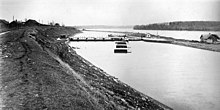
On 22 April 1887, as requested by Stormont Electric, the town council passed a by-law giving the company the exclusive right to erect poles and string wires for the distribution of electricity across the town for fifteen years, and a tax exemption on the personal and real property of the company for a period of ten years. Stormont Electric then filed for incorporation with the provincial government as a joint-stock company, valued at $25,000. Company solicitors also prepared a deed of purchase for the use of the water-power plant in a building on land used for a gristmill, and controlled by David Hodge. It was passed on to him by his father Andrew Hodge, who was key to Cornwall's economic growth, and who years earlier, had purchased the mill, which included federal water rights on the Cornwall Canal.[3]:2,13
In September 1887, Hitchcock obtained title to his company's electric plant, and agreed to operate it for one year, and to give the directors of Stormont Electric options to purchase the operation, before being free to sell it to anyone else. In October that year, Hitchcock borrowed $5,000 from them to pay his bills, and unable to repay the ten-month loan, would forfeit ownership of his power plant to Stormont Electric.[3]:19
Expansion and control
On 1 December 1893, the directors of Stormont Electric decided to operate the Cornwall Gas Works Company, when the shareholders, seeing it as a potential rival, had agreed to purchase the company. After being in abeyance for several years, the High Court of Justice for Ontario, issued a final order of foreclosure on 13 April 1890. Once the terms and conditions of the purchase were finalized, Stormont Electric purchased the company in 1895, for $13,000. An act passed in the provincial legislature of Ontario, provided Stormont Electric with the necessary permission to operate Cornwall Gas Works, allowing it to manufacture and sell gas for light, power, and heat in the town and township of Cornwall, and to increase the value of its capital stock by $50,000.[3]:26-27,93
Facing an increasing demand for electricity, the directors of Stormont Electric decided to build a new coal powered steam plant to supply power when the Cornwall Canal had an insufficient amount of water to turn the water wheels fast enough to generate electricity. To finance the project, which included a new boiler, engine house, and approximately 150 tons of soft coal to power the steam engines, the directors secured a $10,000 loan against the company's property and equipment, from James N. Stuart, an investment agent of Montreal, Quebec.[3]:22
During the 1896 yearly municipal elections, the incumbent mayoral candidate M. M. Mulhern had proposed expropriation of the water and electric utilities. Stormont Electric was able to escape the idea of expropriation, which had been deemed inappropriate at the time by William Hodge, a candidate for Reeve and a former director of Stormont Electric.[3]:30
Five years later, in 1901, Cornwall had assumed control of the waterworks and formed a special investigative committee to determine whether it would be more economical to build a new electric plant or acquire the gas and electric plants operated by Stormont Electric. After receiving the committee's report which favoured purchasing the two plants, council provided Stormont Electric with a formal offer to purchase the plants and related assets for $50,000 on 27 November 1901, giving the directors one month to decide, before withdrawing the offer. The offer was declined, and to show its displeasure, council decided not to renew the agreement it had with Stormont Electric, and instead placed the street lighting services it provided up for tender.[3]:33
To help with the planning, specifications, and bid proposals, the town council enlisted the services of W.R. Hitchcock.[3]:34 Cornwall Electric Street Railway which also produced electricity, was reorganizing itself and facing a corporate takeover by the Sun Life Assurance Company of Canada, which did not want to participate in the tendering process.[3]:36 The remaining bids were from Stormont Electric, and St. Lawrence Power Company, which had strong connections with the federal Conservative government, which had awarded it lucrative contracts, including one to bring power to the Cornwall Canal to operate the locks and to furnish it with lights. After much deliberation, and finding the St. Lawrence bid too high, and reluctant to build a new plant, council would reverse itself, by signing a ten-year contract with Cornwall Electric on 4 June 1902.[3]:40
To support its growth, Stormont Electric also signed a contract to purchase additional power from St. Lawrence Power on 26 October 1903, which included an agreement to build a power step down transformer station on its property south of the Cornwall Canal, and a commitment from St. Lawrence Power that it would not supply power to individuals or corporations in Cornwall, excluding the Canadian Colored Cotton Mills, and to not supply power to villages surrounding Cornwall.[3]:41
The insurance company
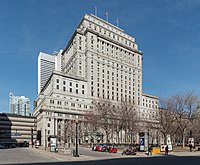
As early as 1898, the Sun Life Assurance Company of Canada had begun to purchase bonds issued to Cornwall Electric Street Railway. Cornwall Electric was in financial trouble and was unable to repay those bonds, giving Sun Life, ownership of the railway company in 1902.[5]
In December 1904, James Leitch, president of Stormont Electric received a letter from Sun Life expressing its desire to purchase the company. The directors, all prominent businessmen and active members of the community, who had previously refused the town's offer of $50,000, accepted in 1905, Sun Life's offer to purchase the company's stock valued at $37,100.[3]:89-90 Sun Life would consolidate the two operations, sharing management and overhead costs, and using its electricity to power the streetcar services, and to distribute it to consumers.[5] It would make William Hodge, a former director of Stormont Electric, and familiar with the town's people, the first general manager of the combined companies, and who would later become the first vice-president.[3]:92,112
Public ownership
Like many municipalities in Ontario, Cornwall was tempted in 1912 to join the new provincial publicly-owned Ontario Hydro. Enticed by the promise of lower rates and "people's power" to join the public utility, residents were unswayed. Between 1919 and 1920, pro-Hydro and anti-Hydro forces engaged in many heated discussions. Some had seen Ontario Hydro as becoming a huge monopoly, initially offering lower rates, but not maintaining them.[7] The debates culminated into a referendum, whereby the ratepayers of Cornwall in a 799 to 540 vote, enacted a by-law to renew the company's franchise, keeping the utility under local control and in private hands for another ten years.[8] This provided Cornwall with stable rates, while all the Hydro-towns were subjected to rate increases. Unlike Cornwall, they were unable to choose another provider of electricity once connected to the public grid.[3]:123,144
.jpg)
It was later revealed that Adam Beck, former chairman of the Hydro-Electric Power Commission (HEPC), who had unsuccessfully tried to convince the citizens of Cornwall to switch to Ontario Hydro, used his influence and the strength of his position, to offer the Eugene Phillips Electric Company, a more favourable electricity rate, if it relocated to the public-Hydro town of Brockville, Ontario, instead of Cornwall, during the time the company was negotiating with Cornwall's Board of Trade and town council. Cornwall Mayor Chisholm and council were outraged, and appealed to the provincial government, which after receiving other complaints, established the Gregory Royal Commission to investigate the HEPC. In this regard, the Commission found that HEPC, had improperly contributed $805 of public funds to the pro-Hydro Citizens League, had discriminated against Cornwall, and had made arrangements to shut Cornwall out of getting an independent source of power, which it deemed to be "coercion of a character seldom adopted by a public body".[3]:143
St. Lawrence Power
By the 1920's, Stormont Electric had become more dependent on the power it purchased from St. Lawrence Power, and would eventually relegate its own power house to backup service only, which it operated on its property located on the south side of the Cornwall Canal and where St. Lawrence Power had installed the step down substation. Cornwall Electric would later decide to move its power house to the north side of the canal on the railway car barn property it expanded with the 1934 purchase of the adjacent lot, eliminating the need of stringing and maintaining wires across the canal bed.[3]:145-146
Cornwall Electric aggressively promoted its electrical businesses. In 1920, Cornwall had only four electric ranges, and by 1930, ownership had increased to eight-hundred electric ranges. Similar electric appliance initiatives raised resentment from private appliance dealers in places that were connected to the publicly-owned Ontario Hydro.[7] It would also sell electric hot water heaters, with off meter electricity, paid for using a flat rate system, and which it could turn on and off remotely during peak hours. The sale of hot water heaters and electric appliances were eventually abandoned, and the flat rate system discontinued.[3]:224-225
Aluminum Company of America
Unlike most towns during the depression years of the 1930s, Cornwall was facing industrial expansion and population growth, increasing the demand for more power by three-hundred percent. Cornwall Electric would now obtain all its power from St. Lawrence Power, which received its power from the Cedars Rapids Transmission Co. Ltd., which primarily supplied power to its then parent company, the Aluminum Company Of America (ALCOA) which operated an aluminum smelter located near Cornwall in Massena, New York.[3]:164 Under an 85-year contract that extended to the year 2000, Cedar Rapids agreed to purchase 56,000 kW of power from Hydro-Québec, and if available, could purchase an additional 50,000 kW. It also had a license from the Government of Canada to export 75,000 kW of surplus power at the entry point of Massena, New York, for its aluminum plant. The Niagara Mohawk Power Corporation, also based out of New York State, and then owners of St. Lawrence Power, had agreed to provide up to 56,000 kW of power at Massena, if Cedar Rapids, fulfilling purchases made by St. Lawrence Power to service the Cornwall area, was unable to meet the power needed at the ALCOA plant.[3]:212
Saint Lawrence Seaway
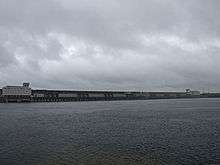
The Moses-Saunders Power Dam, a part of the Saint Lawrence Seaway which was completed in 1959,[9] and which is situated on the west side of Cornwall on the Saint Lawrence River, supplies water to two adjacent Canada-US hydroelectric power generating stations, operated by Ontario Power Generation (OPG) and the New York Power Authority. Cornwall Electric does not purchase any power generated there, due in part to a long-standing Ontario Hydro policy of not supplying power long-term to privately held companies,[3]:213,215 and the affordability and abundance of power available close-by in the neighbouring province of Quebec.[10]
Municipal ownership
By the early 1970s, Sun Life began to slowly divest itself of Cornwall Electric's railway assets.[11] In 1972, the Kingston, Ontario firm Klondike and Lemoyne Company Limited showed interest in purchasing Cornwall Electric, and when negotiations took a more serious turn, Sun Life after seventy-five years of ownership and now wanting to unload what remained of Cornwall Electric, advised Cornwall city council that it was planning to sell the company.[7]
The city council, under the leadership of Mayor Gerald Parisien, announced on 30 June 1977 that it sent Sun Life, a letter of intent to purchase the company with an offer of $4.8 million, under a deadline of 25 July 1977. On the condition that the terms of sale be finalized by that deadline, Sun Life accepted the offer. Later that year, the city of Cornwall appointed members to its first board of directors. They were Mayor Gerald Parisien, who also served as president, Albert Bergeron, owner of Bergeron Electric, Fred Bradley, former comptroller at the local textile plant Courtaulds (Canada) Limited, Neil Burke, President of the local car dealership Brookshell Pontiac Buick, and Douglas Fawthrop, former city alderman. Gordon Fairweather would remain as vice-president and general manager.[3]:260
Cedars Rapids Transmission
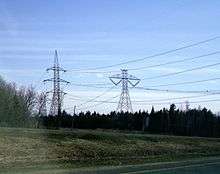
In 1980, Cornwall Electric and St. Lawrence Power had approached ALCOA to discuss the possibility of purchasing Cedar Rapids, but after only agreeing to consider the matter, nothing came of it until 1983, when Cedar Rapids decided to terminate the contract it had with St. Lawrence Power to pursue other alternatives. After this, the Cornwall Electric board of directors hired the firm Touche Ross to prepare a feasibility study on purchasing both St. Lawrence Power and Cedar Rapids. After recommending that it should, General Manager Gordon Fairweather and the board of directors once again approached ALCOA in early 1984. This time, a committee was struck which negotiated until early 1985.[3]:292-293
In July 1985, ALCOA announced that it had sold Cedars Rapids Transmission Company Limited to Hydro-Québec for an amount that ranged between 65 and $70 million. Hydro-Québec agreed to honour the contract Cedar Rapids had just renegotiated with St. Lawrence Power. Two years later, after three previous attempts, Cornwall Electric acquired the St. Lawrence Power Company from Niagara Mohawk Power for $13.5 million.[12][3]:292-293.
The Cedars Rapids Transmission line which crosses provincial and international boundaries feeds Cornwall Electric with the power it requires directly from Hydro-Québec.[13][14] It is a 72-kilometre (45 mi) double-circuit 120-kilovolt (kV), 325-megawatt interconnection line. The line runs along its right-of-way, and links between the Hydro-Québec TransÉnergie grid at the Les Cèdres substation in Quebec, to the National Grid Dennison substation in the state of New York.[15] The line was rebuilt in 2003 and operates at 120 kV. It is capable of operating at 230 kV with a capacity of 1,000 megawatts.[16]
Energy dependence
In 1994, Cornwall Electric, concerned about its energy dependence on just one supplier, awarded a contract to Marsh Energy Inc. to design the first municipally-owned hot water district heating and cogeneration system in Canada.[17] The plant went online in 1995 and is operated by CDH District Heating Limited, a subsidiary of Fortis Ontario Inc. The system feeds 5 megawatts electric (MWe)[18] of base load electricity into the municipal grid, and provides 7 megawatts thermal heat (MWth)[19] to city buildings, schools, and a hospital via a 4.5-kilometre (2.8 mi) underground distribution network.[20]
Privatization
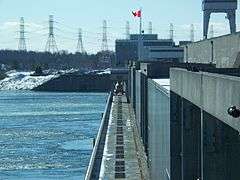
In an attempt to lower electricity rates, the Government of Ontario had proposed legislation that would restructure the electricity market in the province. The Cornwall Electric board of directors concerned with the possible adverse impact this could have on the company, presented options to city council. Viewing privatization as the best option, council would quietly seek a buyer for the company. After several months of searching, it found one that was eager to be first in the new electricity market and willing to pay twice the company's value to acquire Cornwall Electric[12].
In 1997, after twenty years of ownership, city council announced that it had made the decision to sell Cornwall Electric to Consumers' Gas Company Ltd. Residents concerned with that decision and who saw Cornwall Electric as the city's "crown jewel", formed an organization called Cornwall Ratepayers Against Panic-selling of Cornwall Electric (CRAP). A proponent of the organization was a former Cornwall mayor, Nick Kaneb.[21] Despite the opposition, city council voted in a 10-1 decision[22] to sign a Memorandum of understanding. On behalf of the Corporation for the City of Cornwall, it accepted the offer from Consumers Gas to purchase Cornwall Electric for $68 million.[12] Ernie Jackson, a former general manager of Cornwall Electric recalled "that during the time of the sale, the company was entering a time of high risk, and said it was a good idea to put control of Cornwall Electric into private hands where the focus could be solely on keeping it profitable".[23]
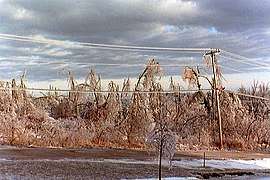
Ice storm
The sale of Cornwall Electric was set to occur in February 1998 but was delayed due to the January 1998 North American ice storm. During the prolonged ice storm, much of Eastern Ontario and Western Quebec was without electricity. Cornwall which is situated on the banks of the Saint Lawrence River, which supplies water to the neighbouring hydroelectric R.H. Saunders Power Generating Station, also had no electricity, until existing wires connecting the Moses-Saunders Power Dam to Cornwall were for the first time energized with electricity generated by the local power plant. Two of the three wires were weighted down by ice and were hazardously close. A Cornwall Electric employee who was also an archer, used a bow and arrow to throw a line over the arcing wires. Workers were then able to bounce the wires, causing the ice to fall off and the hydro lines to separate from each other. This allowed Cornwall residents to have enough power to meet seventy-five percent of their electricity needs during the ice storm.[12]
Progress Fund
After paying off the city's debt with the sale of Cornwall Electric, the city of Cornwall created the Progress Fund with the remaining proceeds.[24] It would later protect the fund by passing a by-law equipped with a funding mechanism requiring the fund to hold a minimum balance of $25 million.[25] Originally, it would only fund quality of life projects in the city of Cornwall. Interest generated by the fund has been used in part for the redevelopment of the local Hotel Dieu Hospital, later renamed the Cornwall Community Hospital, the establishment of a hospice, the building of an aquatic centre, and to pay the mortgage on the city's new sports complex, the Benson Centre.[26]
New ownership
In May 2002, Enbridge Energy Distribution Inc. (formerly Consumers Gas), announced that it had agreed to sell Cornwall Electric to Fortis Inc. in a cash deal worth $67 million. Both the Canadian Competition Bureau and the Ontario Energy Board approved the sale which Fortis Inc. concluded on 18 October 2002. Fortis has its roots in St. John's, Newfoundland, and is a Canadian multinational publicly traded holding company which operates Cornwall Electric under its Ontario subsidiary, Fortis Ontario Inc.[27]
In 2016, Cornwall Electric entered into a ten year agreement, commencing 1 January 2020 with Hydro-Québec Energy Marketing, to purchase a minimum of 537 gigawatt hours (GWh) per year, and up to 145 megawatts of capacity at any one time.[13]
LED adoption
In 2016, after an initial test run in certain areas, the city of Cornwall which still owns the utility poles and lights, converted approximately 5,000 street lamps to LED bulbs. The cost of the project was $3 million. The city also announced that it would be switching its street traffic lights to LED at a rate of two intersections per year.[28]
In 2017, Hydro One converted most of the nearby township of South Glengarry to LED bulbs, except for the village of Glen Walter, which borders the city of Cornwall and is serviced by Cornwall Electric.[29] In 2019 the Township of South Glengarry also wanted Cornwall Electric to convert Glen Walter to LED lighting.[30] At a special council meeting on 24 January 2020, Councillor Sam McDonell raised the idea of not paying its electricity bill, as a way to bring Cornwall Electric to the table to discuss the matter.[31]
Railway operations
Cornwall Street Railway Company
The Cornwall Street Railway Company would be the first attempt at providing Cornwall with public transportation when it filed a charter to build tram lines for horse drawn streetcars. The company received letters of patent from the Province of Ontario on 11 November 1885, and was capitalized at $30,000. On 14 December 1885, Cornwall passed a by-law that would provide the railway company with ten years free of property taxes, and the exclusive right to operate in Cornwall for twenty years. The by-law would also stipulate that the railway company would be responsible for paving and maintaining the space between the rails, be permitted to operate sleighs instead of wheeled vehicles during the winter months, and be obligated to run the passenger service every hour between 7 am and 7 pm, at no more than five cents per adult passenger, except between 8 pm to 11 pm, when the fare could be doubled.[32] The by-law also included fines of $50 or jail time of twenty days for anyone blocking the passage of the horse drawn cars. No evidence could be found, indicating that the company had ever started offering its railway service.[3]:46-47
Cornwall Electric Street Railway Company Limited
_(36520200630).jpg)
Ten years would pass, before the town council granted on 28 December 1895, another franchise to the Cornwall Electric Street Railway Company, which incorporated in 1896 to offer the same service, using electrical power instead of horse power.[33]
On 22 January 1894, W.R. Hitchcock would take the initial steps to bring to Cornwall an electric street railway for which he received franchises from the town and township of Cornwall. Inexperienced in the matters of building a railway, Hitchcock signed an agreement with the firm Hooper and Starr to build it. The contractors would become principal stockholders and directors of the railway, after Hitchcock transferred his franchise rights in January 1896, to the newly-formed Cornwall Electric Street Railway Company Limited, where he would be superintendent.[3]:49-52
Cornwall Electric, started its passenger streetcar service on 1 July 1896 using an electric locomotive pulling four cars traveling on what was approximately 4.8 kilometres (3.0 mi) of track, and would purchase an additional two cars in 1897.[4]
In need of additional revenues, Cornwall Electric would start a freight service for which it purchased two new freight locomotives in 1899. The service would move freight from the Grand Trunk Railway yards, and from the New York and Ottawa Railway to the Toronto Paper Company, Canadian Coloured Cottons, and other businesses, including moving mail for the town's post office. It would end its streetcar service, switching instead to trolleybus service in 1949.[34]
During the time Stormont Electric was planning to expand its operation, Cornwall Electric Street Railway included in its charter the right to generate electricity for heating, lighting and power. The company was looking for ways to turn its financial difficulties around. Although it was not in a position to compete against Stormont Electric, its general manager David Starr was contemplating purchasing the company, in order to power its streetcar service with electricity that was not being used during the day.[3]:32
In a 1970 Act of the Legislative Assembly of the Province of Ontario, Cornwall Electric received authorization to sell the railway freight operations, including equipment, buildings, tracks, and lands with rights-of-way.[35] The Canadian National (CN) purchased the freight operations on 1 April 1971 for $430 thousand. The passenger service was contracted out to A.J. McDonald Limited.[11] In 1972, the Kingston, Ontario firm Klondike and Lemoyne Company Limited wanted to purchase Cornwall Electric, and when negotiations took a more serious turn, Sun Life advised Cornwall city council that it was planning to sell the company.[7]
Community involvement
Historically, many of the company's general managers and directors contributed to the future development of Cornwall by working with the local Board of Trade and town council. They would encourage Sun Life to invest in many large companies that would agree to locate to Cornwall.[3]:155 It would finance the building of the Water Street Arena to replace the Victoria Rink which was lost in the Cornwall "great fire of 1933". Arrangements were also made to purchase the home of W.R. Hitchcock, founder of the Cornwall electric and railway companies who was at the time facing adversity. This allowed him to continue living there until his death on 4 June 1944.[3]:167
In December 2012, it donated $50,000 to the To Your Health Campaign in order to purchase an MRI and a digital urology table for the Cornwall Community Hospital.[36] In June 2011, Cornwall Electric donated $40,000 towards the purchase of the main rink score clock in the new community complex, the Benson Centre.[37]
The company has been a donor and sponsor of the River Institute.[38] In May 2018, it made a $2,000 donation towards the Educational Programs for Youth, which brings students seeking a career path in environmental sciences, together with scientists and biologists.[39] In July 2017, it sponsored the Kid Zone at Canada's 150th Birthday by providing a $5,000 donation to the Canada Day Committee. In August 2017, the company participated in the One Bag Challenge to help the local food bank, the Agape Centre, to which it donated $10,000 in 2015.[40]
On December 10, 2019, employees of Cornwall Electric participated in the local organization Rachel's Kids House of Hope Bear-A-Thon and delivered the bears, along with other gifts to a family of three siblings, using a company utility truck. Rachel's Kids Executive Director, Kim Lauzon stated: “The Cornwall Electric team wanted to pick out the gifts for the family themselves and they brought the truck to show the boys.”[41]
See also
- Cornwall, Ontario
- Moses-Saunders Power Dam
- R.H. Saunders Power Generating Station
Footnotes and charts
- 2017 Ontario Energy Board Electricity Rate Comparison[42]
- 2016 Ontario Energy Board Electricity Rate Comparison[43]
- As of 2017, the Ontario Energy Board (OEB) no longer includes Cornwall Ontario in its electricity rate comparison charts.
Licensing
Cornwall Street Railway Light and Power Company is registered as an Ontario Business Corporation, and has the Registry ID 752855, issued by the province of Ontario on 1 January 1988. Its Electricity Distribution Licence is ED-2004-0405 which was issued by the Ontario Energy Board on 10 November 2004, last amended on 17 March 2017, and valid until 31 December 2030.[44]
Although licensed by the OEB, Cornwall Electric has been granted legislative exemptions under the 1998 Ontario Electricity Act.[45] The company is subject to a 35-year Franchise Agreement with the city of Cornwall, which dates back to 31 July 1998. It also has Franchise Agreements with the neighbouring townships. Under the agreements, electricity rates are reset every year, and calculated based on a formula that includes adjustments for inflation, load growth, and customer growth.[46]
References
- "Why do people in Cornwall have lower electricity bills than you? | Ontario Clean Air Alliance". Clean Air Alliance. September 2016. Archived from the original on 31 August 2020. Retrieved 3 April 2020.
- "Electricity Distributor Performance - Rates Comparison - Estimated Total Bills for Ontario Distributors". Ontario Energy Board. November 2016. Archived from the original on 19 June 2019. Retrieved 4 April 2020.
- Carter-Edwards, Karen (1987). Cornwall Electric, 100 Years of Service. Canada: Cornwall Electric. ISBN 0-9692908-0-2.
- "Transit History of Cornwall, Ontario". University of Manitoba. April 2011. Archived from the original on 9 December 2019. Retrieved 4 April 2020.
- "Cornwall Street Railway Light & Power Co". Train Web. October 2009. Archived from the original on 28 August 1999. Retrieved 25 April 2020.
- Palermo, Elizabeth (17 February 2017). "Who Invented the Light Bulb?". Live Science. Archived from the original on 15 June 2020. Retrieved 18 July 2020.
- "Urban History Review" (PDF). Érudit. February 1988. p. 295. Archived (PDF) from the original on 14 August 2017. Retrieved 16 May 2020.
- "Cornwall Street Railway from Canadian Railway and Marine World/Canadian Transportation" (PDF). Colin Churcher's Railway Pages. August 2017. p. 434. Archived (PDF) from the original on 16 May 2020. Retrieved 16 May 2020.
- "The Seaway Story". Great Lakes St. Lawrence Seaway System. Archived from the original on 17 June 2020. Retrieved 25 July 2020.
- Chung, Andrew (20 August 2010). "As Quebec bathes in electricity, money goes down the drain". The Star. Toronto Star Newspapers Ltd. Archived from the original on 9 June 2020. Retrieved 9 June 2020.
- "Cornwall Transit - CPTDB Wiki". Canadian Public Transit Discussion Board. January 2020. Archived from the original on 17 June 2009. Retrieved 25 April 2020.
- Hale, Alan S. (26 September 2019). "A look at the history of the privatization of Cornwall Electric, 21 years later". Cornwall Standard-Freeholder. Postmedia. Archived from the original on 30 September 2019. Retrieved 4 April 2020.
- "Annual information form for the year ended December 31, 2019" (PDF). Fortis. 12 February 2020. p. 23. Archived (PDF) from the original on 19 May 2020. Retrieved 20 May 2020.
- "Exchanges with Ontario | International | Hydro-Québec". www.hydroquebec.com. Retrieved 21 July 2020.
- "Point of delivery/receipt DEN and point of delivery CORN" (PDF). AATI. April 2014. Archived (PDF) from the original on 18 May 2020. Retrieved 18 May 2020.
- "The Cedars Rapids Transmission Co. (CRT)". Hydro-Québec. January 2004. Archived from the original on 10 May 2019. Retrieved 18 May 2020.
- "Cornwall Electric District Heating Plant" (PDF). Power Genysys. August 1995. Archived (PDF) from the original on 15 May 2020. Retrieved 15 May 2020.
- "Megawatts electric - Energy Education". Energy Education. April 2020. Archived from the original on 5 February 2016. Retrieved 15 May 2020.
- "Megawatts thermal - Energy Education". Energy Education. April 2020. Archived from the original on 23 June 2016. Retrieved 15 May 2020.
- "Cornwall, Ontario District Heating System" (PDF). Natural Resources Canada. August 2008. Archived (PDF) from the original on 11 July 2017. Retrieved 15 May 2020.
- "Omni". Trent University Library and Archives. March 2004. Archived from the original on 16 May 2020. Retrieved 16 May 2020.
- "Cornwall City Council Meeting Minutes - No. 27-97" (PDF). City of Cornwall. October 1997. Archived (PDF) from the original on 16 May 2020. Retrieved 16 May 2020.
- Hale, Alan S. (23 September 2019). "Sale of Cornwall Electric commemorated at city hall". Cornwall Standard-Freeholder. Postmedia. Archived from the original on 26 September 2019. Retrieved 4 April 2020.
- "City of Cornwall Progress Fund Investment Register" (PDF). City of Cornwall. June 2019. Archived (PDF) from the original on 15 May 2020. Retrieved 15 May 2020.
- "City put $25M Progress Fund in jeopardy: auditor – Cornwall Newswatch". Cornwall Newswatch. May 2019. Archived from the original on 7 July 2019. Retrieved 5 April 2020.
- "Cornwall hit 'sweet spot' in '98 sale of Cornwall Electric". Cornwall Newswatch. September 2019. Archived from the original on 26 September 2019. Retrieved 6 April 2020.
- "Enbridge Sells Cornwall Electric". Oil & Gas Journal. 17 May 2002. Archived from the original on 11 July 2020. Retrieved 11 July 2020.
- "5,000 city street lights being replaced with LED". Cornwall Seaway News. Rick Shaver. 11 April 2016. Archived from the original on 22 April 2020. Retrieved 3 April 2020.
- "Township of South Glengarry Regular Meeting of Council" (PDF). South Glengarry. 21 February 2017. Archived (PDF) from the original on 7 June 2020. Retrieved 7 June 2020.
- "Glen Walter held hostage to old streetlights". Cornwall Newswatch. March 2019. Archived from the original on 19 October 2020. Retrieved 6 April 2020.
- Seebruch, Nick (January 2020). "SG Council considers not paying Cornwall Electric bill". Cornwall Seaway News. Rick Shaver. Archived from the original on 8 April 2020. Retrieved 4 April 2020.
- Clegg, Anthony; Lavallée, Omer (2007). Cornwall Street Railway, The Insurance Company's Streetcars (5 September 2014 ed.). Cornwall, Ontario: Railfare DC Books. p. 11. ISBN 978-1-897190-25-8.
- "Significant Cornwall Railway Dates | New York Central - Ottawa Division". Archived from the original on 4 April 2019. Retrieved 5 June 2020.
- Hale, Alan S. (2 December 2019). "A history of transit in Cornwall". Cornwall Standard-Freeholder. Postmedia. Archived from the original on 3 December 2019. Retrieved 25 April 2020.
- "An Act respecting Cornwall Street Railway, Light and Power Company Limited". York University, Osgoode Hall Law School. Queen's Printer for Ontario. 1970. Archived from the original on 6 June 2020. Retrieved 6 June 2020.
- "Cornwall Electric donates to the To Your Health! Campaign | Cornwall Electric". Cornwall Electric. September 2018. Archived from the original on 11 September 2013. Retrieved 18 May 2020.
- "Cornwall Electric powers up $40,000 for new Benson Centre | Cornwall Electric". Cornwall Electric. September 2018. Archived from the original on 17 August 2012. Retrieved 18 May 2020.
- "Sponsors and Partners – River Institute". River Institute. May 2020. Archived from the original on 13 May 2019. Retrieved 18 May 2020.
- "Cornwall Electric Donates to The River Institute's Educational Programs for Youth | Cornwall Electric". Cornwall Electric. September 2018. Archived from the original on 18 May 2020. Retrieved 18 May 2020.
- "Another sizable donation to Agape Center". Cornwall Newswatch. December 2015. Archived from the original on 24 December 2015. Retrieved 18 May 2020.
- Seebruch, Nick (10 December 2019). "Rachel's Kids and Cornwall Electric powered by the Christmas spirit". Cornwall Seaway News. Rick Shaver. Archived from the original on 11 December 2019. Retrieved 18 May 2020.
- "2017 Electricity Distributor Performance - Rates Comparison - Estimated Total Bills for Ontario Distributors". Ontario Energy Board. November 2017. Archived from the original on 8 January 2020. Retrieved 22 April 2020.
- "2016 Electricity Distributor Performance - Rates Comparison - Estimated Total Bills for Ontario Distributors". Ontario Energy Board. November 2016. Archived from the original on 8 January 2019. Retrieved 24 April 2020.
- "Electricity Distribution Licence ED-2004-0405 Cornwall Street Railway Light and Power Company Limited". Ontario Energy Board. 31 March 2017. Archived from the original on 6 June 2020. Retrieved 6 June 2020.
- "Report of the Ontario Distribution Sector Review Panel" (PDF). Thinking Power. December 2012. Archived (PDF) from the original on 5 January 2019. Retrieved 22 April 2020.
- "Annual information form for the year ended December 31, 2005" (PDF). Fortis. 29 March 2006. p. 26. Archived (PDF) from the original on 19 May 2020. Retrieved 20 May 2020.